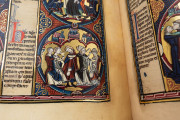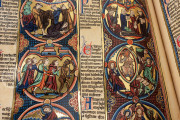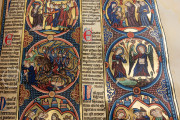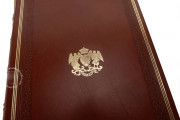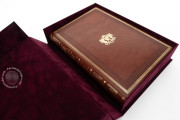Made in Paris around 1230-1234 probably at the behest of Blanche of Castile, Queen of France, for her son's new wife, Marguerite of Provence, the Harley 1527 Bible Moralisée is the final portion of the Oxford-Paris-London Bible Moralisée. It is a moralized Bible, a picture book of biblical stories and their understanding in terms of Christian history and doctrine. Its large pages feature no fewer than 1,200 scenes painted in Parisian Gothic style in a palette dominated by blue, red, and burnished gold.
The Oxford-Paris-London Bible Moralisée is one of a pair of splendid, nearly identical books, the other being the Bible of Saint Louis, probably made for the future Louis IX around the time of his marriage to Marguerite. Both present Israelite and Christian history as recorded in the Bible and thirteenth-century interpretations of that history.
A Picture Book for Edification
A Bible moralisée is a book of pictures meant to edify the Christian viewer. Each episode from the Christian Bible is paired with its "moralization" (a lesson to be learned from the story). The Harley 1527 manuscript is devoted entirely to the New Testament, opening with a harmonized Gospel, that is, an account of the life of Christ that amalgamates and integrates the episodes related in the four canonical Gospels, each pictorially explained.
The Moral of the Story
The vignettes are arranged in two columns of four roundels to be read from top to bottom and left to right, with each biblical scene followed by its "moralization." The moralizations reflect medieval understandings of how the Bible presages and can guide medieval Christian life.
Text as Servant of the Image
The manuscript's text comprises captions for the images. A pen-flourished initial introduces each, which describes the adjacent scene. These captions help the viewer understand the pictures, but the images are the true substance of the book, and the relationship between the biblical scene and its moralization is often expressed most forcefully by compositional mirroring between the two.
Twin Manuscripts
A testament to the fact that the images came first in the minds of the manuscript's creators is the relative stability between the imagery of Oxford-Paris-London and that of the Bible of Saint Louis, created in tandem with it. Tracings made with a metal stylus from a shared model guide the imagery through much of both multi-volume works. The texts, by contrast, are less consistent between the two manuscripts.
Early Arrival in England
The Oxford-Paris-London Bible Moralisée may have been in English royal circles as early as the mid-thirteenth century, perhaps given by Marguerite to her sister Eleanor of Provence (d. 1291), consort of Henry III, King of England. The three- or four-volume book was dispersed after the last quarter of the thirteenth century.
Harley 1526 (with portions of Maccabees) and Harley 1527 traveled together through the hands of one John Thwayte, William Innys (d. 1756), and John Kemp (1665-1717), before Robert Harley (1661-1724), Earl of Oxford, acquired them in 1721. Margaret Cavendish Harley (1715-1785), Duchess of Portland, sold Harley's library to the British Museum to form one of its foundation collections. The manuscripts entered the British Library upon its creation in 1973.
We have 1 facsimile edition of the manuscript "Harley 1527 Bible Moralisée": Bibbia Moralizzata Illustrata facsimile edition, published by Imago, 2023
Request Info / Price







